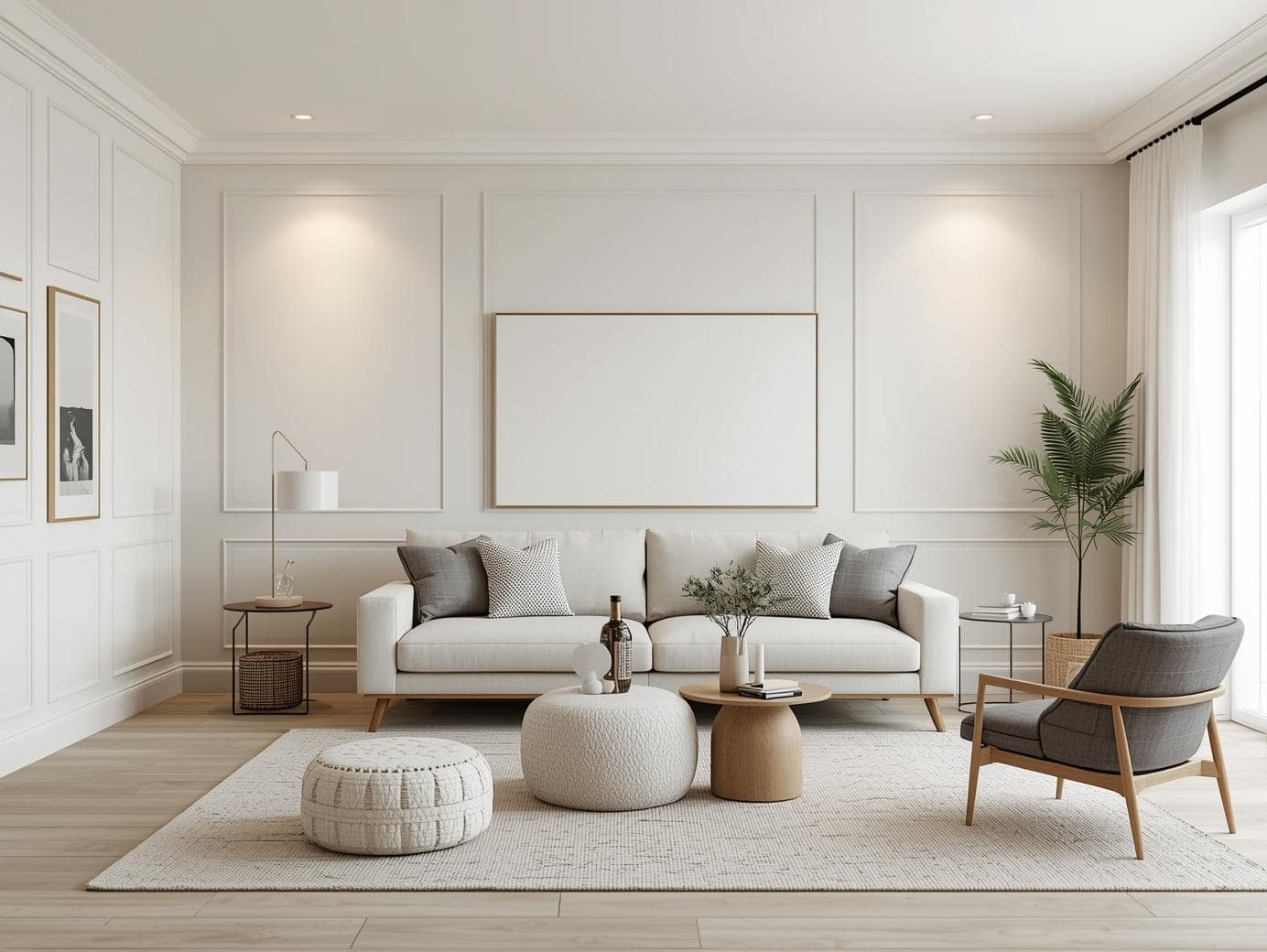In our busy modern lives, our homes have become more than just living spaces, they’re sanctuaries. And with the constant bombardment of stimuli, clutter, and consumer goods, many people are turning to minimalist interior design to create environments that are calming, functional, and beautiful.
Minimalism isn’t just about owning fewer things. It’s a design philosophy and a lifestyle that focuses on intentionality, simplicity, and peace of mind. Whether you’re downsizing, redecorating, or simply craving more breathing room in your life, embracing minimalist design could be the perfect path forward.
In this comprehensive guide, we’ll explore the core benefits of minimalist home design, how it enhances daily life, and how to begin creating a minimalist space that reflects your values and style.
What Is Minimalist Design?
At its core, minimalist design emphasizes “less is more.” It involves removing the unnecessary and keeping only what serves a clear purpose, whether practical or emotional.
Key features of minimalist home design include:
- Open spaces and uncluttered layouts
- Neutral or soft color palettes
- Functional, high-quality furniture
- Natural light and clean lines
- Focus on textures rather than ornamentation
Rather than being cold or impersonal, modern minimalist homes feel warm, calm, and highly livable when done correctly.
1. Minimalist Design Promotes Mental Clarity and Peace
One of the biggest advantages of minimalist design is the mental clarity it brings. A cluttered home can feel overwhelming and stressful, while a simplified space promotes focus and peace.
Scientific research supports this idea. Studies have shown that excess clutter increases cortisol levels (a stress hormone) and negatively impacts productivity and relaxation.
When your home is clean, open, and organized, your mind follows. A minimalist space supports intentional living, where every object has a reason to be there, no more chaos, only calm.
Tip: Begin with a single room. Clear surfaces, remove items you no longer use or love, and observe how your mood changes.
2. A Minimalist Home Is Easier to Maintain
Who wouldn’t want to spend less time cleaning and more time enjoying life? One of the most underrated benefits of minimalist living is how low-maintenance it is.
With fewer items to dust, sort, and store, your home becomes easier to manage on a daily basis. Cleaning becomes faster, and organizing becomes almost effortless.
You also make more thoughtful purchasing decisions, reducing impulse buys and saving money in the long run.
Actionable Tip: Choose furniture that’s easy to clean and serves multiple purposes, like a bench that doubles as storage or a bed with built-in drawers.
3. Enhance Your Home’s Functionality – Minimalist Design
Minimalist interiors are designed to be highly functional. Everything in the space serves a purpose, eliminating distractions and improving flow.
Whether it’s a minimalist kitchen, clutter-free home office, or a streamlined entryway, the emphasis on utility makes daily routines smoother and more enjoyable.
You’ll no longer waste time searching for things or rearranging clutter. Instead, your space will work with you, not against you.
Example: A minimalist living room might feature a simple sofa, one or two essential pieces of furniture, and concealed storage to keep surfaces clean and inviting.
4. Timeless and Versatile Aesthetic
While trends come and go, minimalist design remains timeless. Neutral tones, quality craftsmanship, and simplicity create spaces that age beautifully.
This means you won’t need to constantly update your home to “keep up” with new styles. A well-designed minimalist space evolves with you, offering flexibility and longevity.
Additionally, minimalist homes are adaptable, you can introduce personality through textures, greenery, or a few carefully chosen statement pieces without overwhelming the aesthetic.
Design Tip: Incorporate natural materials like wood, stone, or linen to add warmth and texture to a minimalist space.
5. Encourages Sustainable Living
Minimalism naturally aligns with sustainable living. By consuming less, you reduce your environmental footprint and create less waste.
Rather than filling your home with cheap, fast-made items, you become more intentional, buying high-quality, long-lasting products that support ethical and sustainable brands.
It’s not about perfection but progress. A minimalist lifestyle contributes to a more eco-conscious mindset that benefits both your home and the planet.
Sustainability Tip: Support local artisans or brands that use recycled and eco-friendly materials when purchasing home décor or furniture.
6. Supports Better Sleep and Mental Health
Your environment has a powerful influence on your mental and emotional well-being. A minimalist bedroom, for example, can enhance sleep quality by creating a calming, distraction-free space.
Soft lighting, clutter-free nightstands, and neutral colors help cue the brain that it’s time to unwind. Similarly, a clean and simple bathroom can become a space of rejuvenation and relaxation.
Wellness Tip: Remove tech devices and excessive décor from your bedroom. Opt for calming tones like white, beige, or soft green, and use soft textures like cotton or linen bedding.
7. Fosters Intentionality and Mindfulness
Living in a minimalist home encourages you to be more intentional, not just about design, but about life in general.
You become more mindful of what you bring into your space, how you spend your time, and what truly brings you joy. This intentional living leads to greater contentment, less stress, and more freedom.
Minimalism is about clearing out the clutter to make room for what matters most
Mindfulness Tip: Practice the “one in, one out” rule. For every new item you bring into your home, let go of another to maintain balance.
How to Start Creating a Minimalist Home
Feeling inspired to simplify? Here’s how you can begin:
1. Declutter Ruthlessly
Start small. Go room by room, and remove anything that doesn’t serve a purpose or bring value. Be honest with yourself.
2. Choose a Soft, Neutral Color Palette
White, beige, soft gray, and earthy tones create a calm, cohesive backdrop. Add contrast and warmth with natural materials or greenery.
3. Invest in Multi-Functional Furniture
A minimalist space values quality over quantity. Choose pieces that serve more than one purpose, like a coffee table with storage or a minimalist desk with built-in shelves.
4. Embrace Negative Space
Don’t feel the need to fill every wall or corner. Empty space allows a room to breathe and makes the design feel intentional.
5. Use Hidden Storage Solutions
Keep surfaces clear and clutter-free by incorporating concealed storage in benches, beds, and cabinetry.
6. Decorate Mindfully
Limit decorative items to 2-3 per surface. Choose art, photos, or objects that hold personal meaning or add texture and depth to the room.
Common Myths About Minimalism
Let’s bust a few myths that may be holding you back:
- Myth: Minimalism means owning almost nothing.
Truth: It means owning the right things, what you need and value. - Myth: Minimalist design is cold or boring.
Truth: With the right materials and lighting, it can be cozy, warm, and beautiful. - Myth: It’s expensive to go minimalist.
Truth: You can start small, work with what you have, and focus on fewer, higher-quality investments over time.
Final Thoughts: Simplicity is the Ultimate Luxury
Minimalist design is more than an aesthetic, it’s a way of life. It’s about choosing peace over perfection, purpose over possessions, and designing a space that truly supports your lifestyle.
Whether you’re craving more peace, needing to streamline your space, or simply love clean, timeless style, minimalist design offers a powerful solution. It’s not about having less, it’s about making room for more of what matters.
Want more home inspiration? heck out our latest design guides at Website!




7aspic
cco71a
wio4fp
md1g6k
vql7cp
jnewmi
mp7jxz
vylo8s
uobke3
w99zeg
casino regina
References:
http://mem168new.com/home.php?mod=space&uid=3638120
casino marketing
References:
http://qiaoxiaojun.vip/home.php?mod=space&uid=1738650
konami slot machines
References:
https://git.temporaryname.org/hans2710362868
north brunswick
References:
https://gogs.appcircle.io/sharyntriplett
casino sharon stone
References:
https://generaljob.gr/employer/best-online-casino-australia-for-real-money-2025/
lucky eagle casino
References:
https://fuck.truba-rf.ru/user/forduswkzr
ruidoso casino
References:
https://bookmarks4.men/story.php?title=35-brew-street
casino oklahoma
References:
https://www.forum.uookle.com/home.php?mod=space&uid=1083906